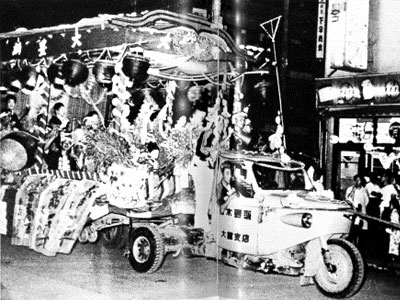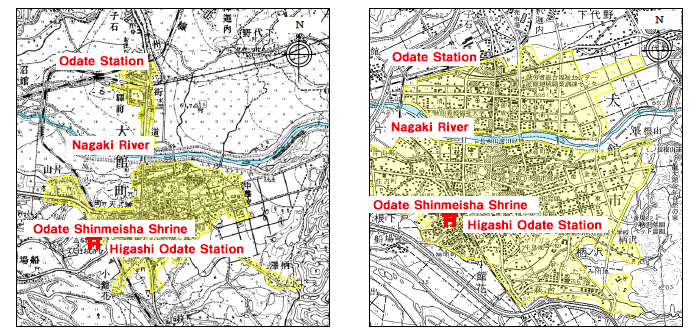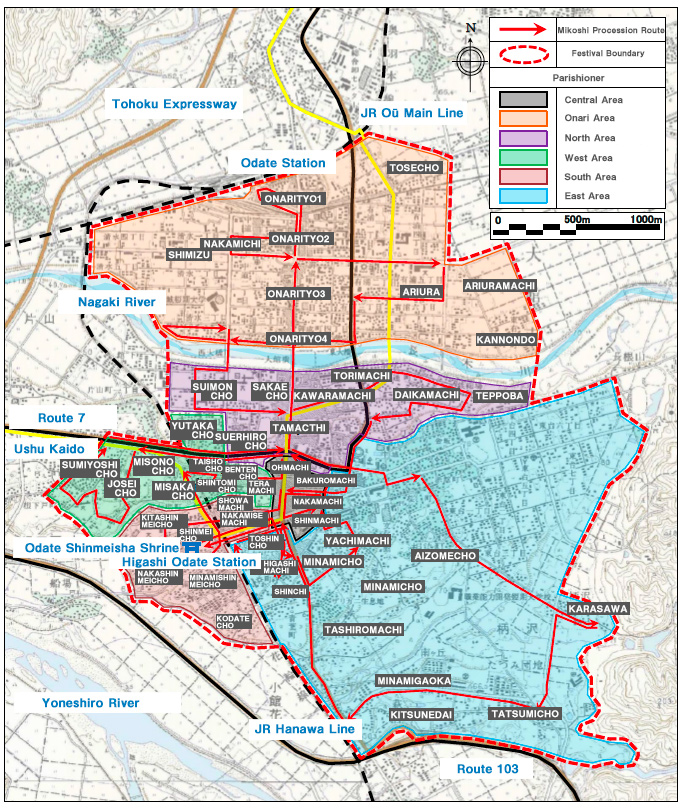Odate Shinmeisha Festival
The Odate Shinmeisha Festival is held every year in central Odate City on September 10th and 11th.
For hundreds of years, Odate Shinmeisha Shrine’s omikoshi portable shrine has been paraded around the city followed by large, elaborate floats that can easily way over 1 metric ton. Dancers on the floats perform to traditional Odate Bayashi music and neighborhoods compete to put on the best show.
Odate Shinmeisha Shrine lies on the western edge of the city which surrounded the former Odate Castle. From the shrine, the old Ushu-Kaido Highway stretches straight east until turning north on Odate’s main avenue where most of the Odate Shinmeisha Festival takes place.
Odate Shinmeisha Festival— Origins
According to the old chronicles, the guardian deity of Odate was enshrined in the Furushinmeisha Shrine in the Kodatebana area of the city. In 1675 the enshrined deity was moved to the current Odate Shinmeisha Shrine. At that time, the family deity of the Akita rulers was also brought to the shrine. The Odate Shinmeisha Festival began when the older Furushinmeisha Festival was combined with the newly established festival in central Odate.
Over the years the shrine was rebuilt several times, but in September, 1870 was completely destroyed along with the portable shrine in a great fire which ravaged the city. According the 1905 records, reconstruction began in 1875 with local residents raising enormous sums of money to fund the project. Construction was finished in autumn of 1876. The portable shrine was rebuilt with monthly contributions from parishioners beginning in 1872 and finishing in 1874.
.jpg)
Odate Shinmeisha Shrine (completed 1876)

Omikoshi portable shrine (completed 1874)
Procession Route—Notable Places
The procession begins at Odate Shinmeisha Shrine and heads out into the four original neighborhoods surrounding the shrine. Next, the omikoshi portable shrine passes by the Furushinmeisha Shrine, the city’s old restaurant district, and Odate Station where a retro Showa-era movie theater still stands.
Odate Shinmeisha Festival—History
A fire in 1870 destroyed the shrine’s records, but it is said that the festival was originally held for three days at the end of July. After the omikoshi portable shrine was rebuilt in 1874, records that show the festival was held on September 14th and 15th. The following year the festival was moved to the 10th and 11th to commemorate a visit to the city by the Emperor.

After the war, there was a period when the Tahoko neighborhood could not gather enough people to pull the float and resorted to using a truck.
During the Meiji era, the omikoshi portable shrine lead the procession followed by tall, elaborately decorated floats. Later, electrical lines became an obstacle to the taller floats. A document from 1897 records, “The Taihoko float on its way to the Tahoko neighborhood crashed into a telegraph wire”. The festival needed to adapt to the changing city.
After WWII, shrine parish grew larger and the number of floats increased. The roads became congested and all the floats could fit inside the shrine grounds. In 1969, it was decided to split the parade and blessing ceremony of the festival into separate events to reduce traffic.
Shrine Expansion and Omikoshi Procession
At the inception of the Odate Shinmeisha Festival, only four neighborhoods—Omachi, Bakuromachi, Nakamachi, and Shinmachi—participated in the festival. These neighborhoods were home to the cities wealthiest merchants and centered around the main business district. As the city grew wealthier and expanded, the shrine parish grew larger as well.
In the late Meiji era, most of the business district and the area south of the Nagaki River joined the Odate Shinmeisha Shrine parish. Even with the influx of new parishioners, the four original neighborhoods remained the most wealthy and generous, as shown in surviving documents. Records show that 85% of the shrine expenses were paid for by the four original neighborhoods, with the remaining 15% split by eleven other neighborhoods.

Town Expansion (Left: 1889, Right: Present day) (Map:Geographical Survey Institute)
As shown in this map from 1947, the area north of the Nagaki River was primarily farmland with the city center located in the south. Now, both north and south of the river consists of residential housing.
While shrine parish originally consisted of four neighborhoods, it grew to contain the new residential areas that were constructed throughout the years. Now forty-four neighborhoods make up the parish, but the original neighborhoods remain at the center of the festival and take turns organizing the ceremonies and rest areas for the omikoshi portable shrine.
Odate Shinmeisha Shrine Parish Committee
| Odate Shinmeisha Shrine | Head Priest | Parishioner Committee | President | 1 |
| Vice-President | 2 | |||
| Permanent Members | 10(Representative of 6 blocks) | |||
| Lower Priest | Director | 3 | ||
| Neighborhood Representatives | Representative |
| Parishioner | Representative | Chart |
| 1,Central Area | 4 | Omachi, Shinmachi, Bakuromachi, Nakamachi |
| 2,Onari Area | 2 | Icchome~Gochome, Shimizucho, Nakamichi, Ariuracho, Higashinaricho |
| 3,North Area | 1 | Sakaecho, Tamachi, Suehiromachi, Kawaramachi, Torimachi, Oshitamachi, Teppoba, Suimoncho |
| 4,West Area | 1 | Bentencho, Shintomicho, Taishocho, Misakacho, Sumiyoshicho, Yutakacho, Misonocho |
| 5,South Area | 1 | Shinmeicho, Minamishinmeicho, Nakashinmeicho, Kitashinmeicho, Nakamesecho, Showamachi |
| 6,East Area | 1 | Higashishinmachi, Hagashimachi, Shinchi, Minamicho, Tashirocho, Karasawa, Aizomecho |
* #1 is the original parish area, all others are later additions.

Odate Shinmeisha Shrine Parish and Festival Map
Festival Floats & Participants
In the past, shrine parishioners would shoulder the omikoshi portable shrine followed by floats from the main neighborhoods (Taihoko, Nakawako, Baryuko, Shinrenko). Wealthy citizens and floats carrying musicians were later added as the festival grew.
Floats were elaborately decorated and grew to be quite tall in imitation of the floats used in the Kyoto Gion Festival. Even through the hard years following WWII and several city-wide fires, the floats remain unchanged. However, as technology progressed and electrical wires became common, the floats had to adapt to overhead obstacles and shrank to their current size. There are currently 14 large floats and 8 smaller portable shrines which are still pulled by neighborhood groups.

Photo showing Taisho period from the Hokushu Club restaurant owner Ishikawa.

Baryuko neighborhood group (1927)